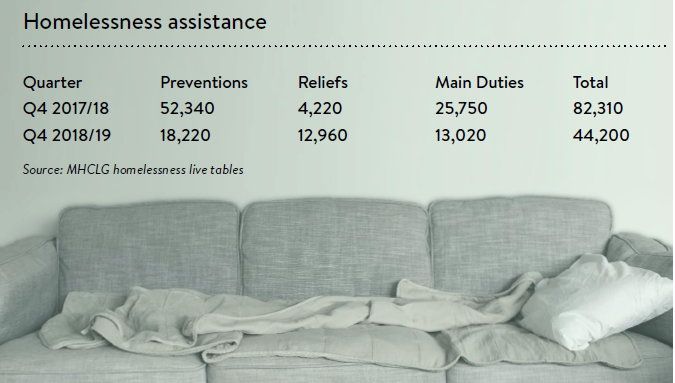Tim Gray, Associate Consultant at Campbell Tickell, reviews the Homelessness Reduction Act, 18 months on from when it first came into force.
The Homelessness Reduction Act (HRA) came into force in April 2018 and was welcomed as a step change for the better. The National Housing Federation called it: “The biggest change to homelessness legislation in 40 years.” (See Box 1: HRA requirements.) So, 18 months on, to what extent is the HRA actually reducing homelessness?
Many English local authorities had already been working hard to prevent homelessness for at least 15 years, with clear government support. Often, however, their resources were focused on households they would have to accommodate if prevention was not successful – that is households deemed to be in priority need because they include dependent children or single people with significant vulnerabilities.
The real hope for improvement under the HRA is for better assistance to those households whom the local authority would not previously have been obliged to accommodate, other than by providing advice and assistance. Crucially, however, even under the HRA, local authorities do not actually have to find a solution for single homeless households. They are merely required to take loosely defined “reasonable steps” to do so. These steps may or may not succeed.
| Box 1: HRA requirements |
| • an extension of the period ‘threatened with homelessness’ from 28 to 56 days; • new duties to try to prevent or relieve homelessness for all eligible applicants, regardless of ‘priority need’; • a duty to produce written ‘personal housing plans’; • a ‘duty to refer’ requiring designated public services to notify a local authority if they come into contact with someone they believe may be homeless or at risk of homelessness within 56 days. |
Single people
So, perhaps the most important question about the HRA is whether it has led to more single people having their homelessness prevented or relieved?
This is in the context of continued problems around housing affordability, the impact of universal credit, the shortage of social housing and deep reductions in funding for supported housing – none of which have been changed by the Act.
Official statistics are now available from the new H-Clic system recording the first year of the HRA. In the last quarter before the HRA, between January and March 2018, 82,310 households were reported as being assisted through a homelessness prevention, relief or main duty acceptance. Between January and March 2019, 44,200 households were similarly helped – a large apparent drop in preventions (see: Homelessness assistance). This may be due to a combination of H-Clic teething problems and a higher standard of evidence required to report a successful prevention, rather than a true reflection of change.
What is already clear, is that the HRA has brought positive changes in local authority practice in dealing with homeless households and greater assurance that single people in difficulty are not merely fobbed off.
The Act has also brought an increase in bureaucracy, however, and louder complaints that the funding required to achieve a real change in single homelessness outcomes has not been provided. New London School of Economics research for London Councils estimates the true cost of a homelessness prevention in London is more than £2,500, compared with £530 used by the government in calculating HRA New Burdens funding.
Has the Homelessness Reduction Act reduced homelessness? Will it do so in the future without an increase in funding? At this point it is hard to tell.
To discuss this article, contact Liz Zacharias : liz.zacharias@campbelltickell.com
This article is also featured in CT Brief, Issue 46 – Health, Care & Support edition
| Campbell Tickell is an established multi-disciplinary management and recruitment consultancy, operating across the UK and Ireland, focusing on the housing, social care, local government, sport, leisure, charity and voluntary sectors.
We are a values-based business and firmly place the positioning of our support and challenge on helping organisations to attain change that is well thought through, planned and sustainable. At CT, we want to help organisations create the landscape within which we ourselves would like to exist: fair, inclusive, diverse, engaged and transparent. We build from our values in how we approach all our work as a practice. Find out more about CT’s Health, Care & Support Services. |



